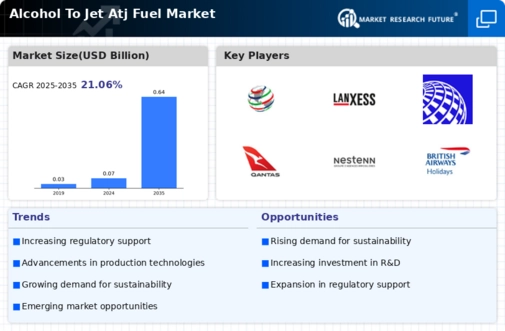Market Growth Projections
The Global Alcohol To Jet Atj Fuel Market Industry is projected to experience substantial growth, with forecasts indicating a rise from 0.07 USD Billion in 2024 to 0.64 USD Billion by 2035. This growth trajectory suggests a robust market potential, driven by various factors such as technological advancements, government policies, and increasing consumer demand for sustainable aviation fuels. The anticipated CAGR of 21.74% from 2025 to 2035 further emphasizes the industry's promising outlook. As stakeholders recognize the importance of transitioning to greener fuel alternatives, the Global Alcohol To Jet Atj Fuel Market Industry is likely to attract significant attention and investment.
Government Policies and Incentives
Government policies and incentives significantly influence the Global Alcohol To Jet Atj Fuel Market Industry, as many nations implement regulations to promote the use of renewable fuels. Various countries are establishing mandates for sustainable aviation fuel usage, which encourages airlines to adopt alternative fuels. Financial incentives, such as tax credits and grants, further stimulate investment in the sector. These supportive measures are expected to propel the market, with projections indicating a growth to 0.64 USD Billion by 2035. As governments continue to prioritize environmental sustainability, the Global Alcohol To Jet Atj Fuel Market Industry is likely to benefit from enhanced regulatory frameworks.
Increasing Investment in Renewable Energy
The Global Alcohol To Jet Atj Fuel Market Industry is witnessing a surge in investment in renewable energy sources, driven by the global transition towards cleaner energy solutions. Investors are increasingly recognizing the potential of alcohol-to-jet technologies as viable alternatives to conventional fossil fuels. This influx of capital is facilitating research and development efforts, leading to innovative production methods and improved fuel quality. As the industry matures, the growing interest from both public and private sectors is expected to bolster market growth. The anticipated CAGR of 21.74% for the period from 2025 to 2035 indicates a robust investment landscape for the Global Alcohol To Jet Atj Fuel Market Industry.
Rising Demand for Sustainable Aviation Fuels
The Global Alcohol To Jet Atj Fuel Market Industry experiences a notable surge in demand for sustainable aviation fuels as environmental concerns intensify. Airlines and regulatory bodies increasingly prioritize reducing carbon emissions, leading to a shift towards alternative fuels. The market is projected to reach 0.07 USD Billion in 2024, reflecting a growing recognition of the need for greener aviation solutions. This trend is further supported by initiatives from various governments promoting the use of biofuels, which could potentially enhance the industry's growth trajectory. As a result, the Global Alcohol To Jet Atj Fuel Market Industry is poised for significant expansion in the coming years.
Technological Advancements in Fuel Production
Technological innovations play a crucial role in the Global Alcohol To Jet Atj Fuel Market Industry, enhancing the efficiency and cost-effectiveness of fuel production processes. Advances in fermentation and distillation technologies are enabling the conversion of biomass into jet fuel with improved yields. These developments not only reduce production costs but also contribute to the overall sustainability of the fuel. As the industry evolves, it is likely that these technologies will attract further investment, fostering growth. The anticipated CAGR of 21.74% from 2025 to 2035 underscores the potential for technological advancements to drive the Global Alcohol To Jet Atj Fuel Market Industry forward.
Consumer Awareness and Preference for Eco-Friendly Options
Consumer awareness regarding environmental issues is reshaping the Global Alcohol To Jet Atj Fuel Market Industry, as travelers increasingly prefer airlines that utilize eco-friendly fuel options. This shift in consumer behavior is prompting airlines to adopt sustainable aviation fuels to meet customer expectations. As a result, the demand for alcohol-to-jet fuels is likely to rise, influencing market dynamics. Airlines that prioritize sustainability may gain a competitive edge, further driving the market's growth. The increasing emphasis on corporate social responsibility among businesses is expected to enhance the visibility and adoption of the Global Alcohol To Jet Atj Fuel Market Industry.






















Leave a Comment